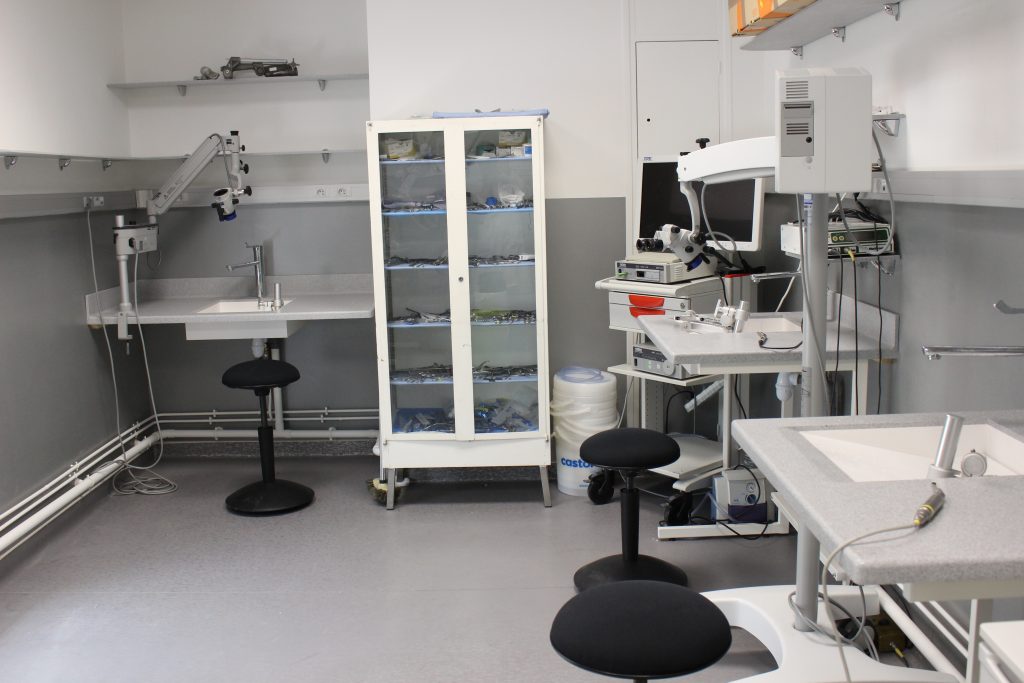Research activities of the Neurosurgery Department
The Skull Base and Cerebrovascular Surgery Laboratory is dedicated to advancing surgical techniques in neurosurgery, and to studying and testing new surgical strategies.
The anatomy of the brain and skull base is the most complex in the body. In-depth 3-D knowledge of this extremely complex environment is a prerequisite for this cutting-edge surgery.
This knowledge enables the neurosurgeon to predict the position of structures at risk, to anticipate and improve the execution of his gestures.
Our laboratory environment enables us to recreate the conditions of a surgical operation, enabling us to simulate, develop and test new surgical techniques.
It also provides training in the meticulous, precise gestures required to perform neurosurgery in these complex regions.
The publication of work carried out in our laboratory in neurosurgical journals, aimed at the neurosurgical community, helps to disseminate these new techniques and strategies.
Workstations
The laboratory has 4 workstations, each with surgical equipment comparable to that of an operating room,
Training courses
Several times a year, our laboratory organizes high-level practical training courses for neurosurgeons wishing to perfect their skills in these cutting-edge techniques.
Laboratory equipment
- Operating microscope- Zeiss
- Endoscope – Storz
- HD video column- Storz
- Medtronic Neuronavigation Station
- High-speed motor – Medtronic
- Mayfiel head holder – Integra
- Microsurgical instruments
- Model for vascular anastomosis
The equipment is provided by our sponsors:
- ZEISS
- STORZ
- INTEGRA
- MEDTRONIC
Fellows and previous research projects
Dr Francesco Corrivetti, Italy: Endoscopic techniques applied to island surgery.
Dr Kenishi Oyama, Japan: V1-V2 anterolateral triangle.
Dr Wei Chieh CHANG, Taishung, Taiwan : Transorbital endonasal approach to the temporal lobe.
Dr Shunya Hanakita, Tokyo, Japan: Deep skull base lesions: Multiportal -multimodal approach.
Dr Hun-Ho Park, Seoul, Korea: Endoscopic endonasal approach to the mesial temporal lobe.
Dr Daniel Ranconi, Belohorizonte, Brazil: Trans-orbital approach to the mesial temporal lobe.
Dr Valentino Tardivo, Turin, Italy: Endoscopic assisted approach to the craniocervical junction through the far lateral approach.
Dr François Rhéault, Canada
Dr Miguel Marigil Sanchez, Madrid, Spain: Comparative study of the transorbital and supraorbital approaches.
Dr Davide Di Carlo, Pisa, Italy: Endoscopic assisted approach of the clivus using the anterolateral approach for the craniovertebral junction.
Dr Calvin Mak, Hong-Kong: Transorbital approach
Dr Steven Hsu, Taipei, Taiwan: Transorbital versus supra-orbital approach
Dr Danilo Malta, Brazil: Combined petrosal approaches and the transposition of the TS-SS junction.
Dr Bremo Camara, Belo-horizonte, Brazil, research topic: Inferior eyelid approach to the mesial temporal lobe
Dr Fumihiro Matano, Tokyo, Japan: Vertebral artery transposition: classification and technique
Dr Atsuchi Okano, Tokyo, Japan: Prelacrymal transmaxillary endoscopic approach to the lateral skull base
Dr Arianna Fava, Pisa, Italy: Minicombined transpetrosal approach
Dr Tancredo Alcantara, Belo Horizonte, Brazil
Dr Jerold Ness, Manila, Philippines

Publications
Endoscope-assisted anterolateral approach to a recurrent cervical spinal chordoma.
How I do it: combined petrosectomy.
Distance Control and Virtual Drilling Improves Anatomical Orientation During Anterior Petrosectomy.
The Chopsticks Technique for Endoscopic Endonasal Surgery-Improving Surgical Efficiency and Reducing the Surgical Footprint. Labidi M, Watanabe K, Hanakita S, Park HH, Bouazza S, Bernat AL, Froelich S. World Neurosurg. 2018 Sep;117:208-220.
Endoscopic Endonasal Approach to the Anteromedial Temporal Fossa and Mobilization of the Lateral Wall of the Cavernous Sinus Through the Inferior Orbital Fissure and V1-V2 Corridor: Anatomic Study and Clinical Considerations. Hanakita S, Chang WC, Watanabe K, Ronconi D, Labidi M, Park HH, Oyama K, Bernat AL, Froelich S. World Neurosurg. 2018 Aug;116:e169-e178.
Combined Nasoseptal and Inferior Turbinate Flap for Reconstruction of Large Skull Base Defect After Expanded Endonasal Approach: Operative Technique. Boetto J, Labidi M, Watanabe K, Hanakita S, Bouazza S, Passeri T, Bernat AL, Froelich S. Oper Neurosurg (Hagerstown). 2019 Jan 1;16(1):45-52.
Endoscopic Approach of the Insula Through the Anterior Middle Temporal Gyrus: A Feasibility Study in the Laboratory.Corrivetti F, Froelich S, Mandonnet E. Oper Neurosurg (Hagerstown). 2017 Jul 25.
Surgical Anatomy for the Endoscopic Endonasal Approach to the Ventrolateral Skull Base. Oyama K, Tahara S, Hirohata T, Ishii Y, Prevedello DM, Carrau RL, Froelich S, Teramoto A, Morita A, Matsuno A. Neurol Med Chir (Tokyo). 2017 Oct 15;57(10):534-541.
Paratrigeminal, Paraclival, Precavernous, or All of the Above? A Circumferential Anatomical Study of the C3-C4 Transitional Segment of the Internal Carotid Artery. Marcati E, Andaluz N, Froelich SC, Zimmer LA, Leach JL, Fernandez-Miranda JC, Kurbanov A, Keller JT. Oper Neurosurg (Hagerstown). 2018 Apr 1;14(4):432-440.
Drilling of the marginal tubercle to enhance exposure via mini pterional approach: An anatomical study and clinical series of 25 sphenoid wing meningiomas. Aldahak N, El Tantowy M, Dupre D, Yu A, Keller JT, Froelich S, Aziz KM. Surg Neurol Int. 2016 Dec 12;7(Suppl 40):S989-S994.
Neuronavigated Fiber Dissection with Pial Preservation: Laboratory Model to Simulate Opercular Approaches to Insular Tumors. Mandonnet E, Martino J, Sarubbo S, Corrivetti F, Bouazza S, Bresson D, Duffau H, Froelich S. World Neurosurg. 2017 Feb;98:239-242.
The Medial Extra-Sellar Corridor to the Cavernous Sinus: Anatomic Description and Clinical Correlation. Theodosopoulos PV, Cebula H, Kurbanov A, Cabero AB, Osorio JA, Zimmer LA, Froelich SC, Keller JT. World Neurosurg. 2016 Dec;96:417-422
Segments of the internal carotid artery during endoscopic transnasal and open cranial approaches: can a uniform nomenclature apply to both? DePowell JJ, Froelich SC, Zimmer LA, Leach JL, Karkas A, Theodosopoulos PV, Keller JT. World Neurosurg. 2014 Dec;82(6 Suppl):S66-71.
Endoscopic, endonasal variability in the anatomy of the internal carotid artery. Cebula H, Kurbanov A, Zimmer LA, Poczos P, Leach JL, De Battista JC, Froelich S, Theodosopoulos PV, Keller JT. World Neurosurg. 2014 Dec;82(6):e759-64.
